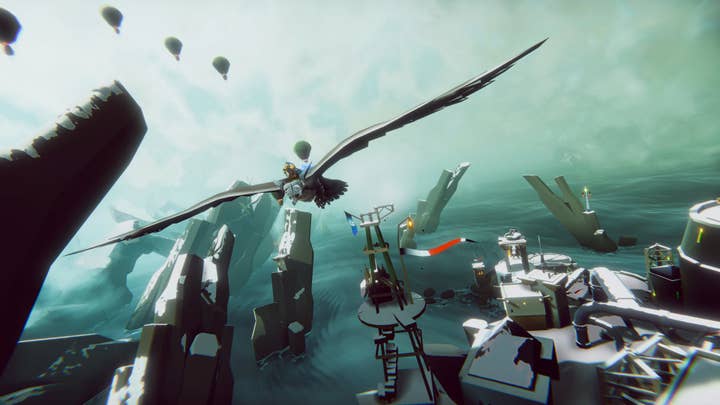How will the Xbox Series X|S and PlayStation 5 benefit indies?
We speak to indie studios and publishers about the possibilities afforded by the new consoles
Whenever new consoles are announced, it's all too easy to get swept up in the excitement for the higher-end games that push cutting-edge hardware to their limits, delivering visuals and experiences not possible with previous machines.
But it's important to consider the implications for smaller independent developers, whose role in the success of PlayStation and Xbox has changed over the past two generations.
During the Xbox 360 generation, Microsoft was heralded as the champion for indies with its Xbox Live Arcade, enabling developers to sell shorter and cheaper experiences directly to consumers in a way that retail -- the then-dominant distribution channel -- never allowed for such titles. As Microsoft's attention waned, Sony and its Strategic Content team picked up the baton, bringing acclaimed indie titles such as Hotline Miami to PS3 and Vita, and giving them pride of place as PS4 approached.
Over the course of the past generation, this has again shifted back toward Microsoft with its ID@Xbox initiative, although indies continued to fare well on both PS4 and Xbox One as digital distribution has matured. And with Microsoft pushing the number of indie titles available through Xbox Game Pass, plus the handful that launched on day one for Xbox Series X|S last week, the company seems keen to be seen as the champion for indies -- at least for the time being.

"History tends to repeat itself in video games, and we're definitely seeing that again now," observes Mike Rose, founder of indie publisher No More Robots. "Whenever a platform holder has arguably 'lost' a console cycle, they tend to then lean more heavily on indie developers for the next cycle.
"When a platform holder is 'winning,' they become more complacent, their business becomes more unwieldy, and more difficult for them to control. As a result, smaller devs get left behind, and the platform holder starts to rely more on the massive AAA hitters. That's why you see this flip-flopping each generation. It's why Microsoft currently seem to have way more plans and support from a wider variety of developers that PlayStation do -- because they've been preparing all of this for years now, to make sure that the Series X is given the best possible chance, whereas PlayStation is attempting to ride the PS4's coat-tails.
"Of course, if Microsoft pulls it off, then it's likely that we'll see the same shift happen again in a few years, and a larger focus on AAA on Xbox Series X. I think it's safe to say the games industry has never learnt what the definition of insanity is."
Larian Studios' director of publishing Michael Douse notes that PlayStation has still given plenty of focus to indies in its digital showcases this summer, but the interesting thing is that it doesn't position these titles as indie games -- they're just games.
"We are finally at a point where indie devs can join in on launch line-ups of console generations"
Alex Nichiporchik, TinyBuild
"This is important because it reflects changes in attitude to the lesser-known areas of game creation, such as promotion and distribution," he says. "If you look at the majority of the highest rated games over the past years, you could argue that a large percentage of those are indie titles. They're sought after, they're high quality, they're what players want. They are simply 'games' and now they're being treated as any other type."
Look at the launch line-ups for both consoles and you'll see they're still dominated by AAA cross-gen releases and -- in Sony's case -- brand new first-party offerings. Yet indie games are still present, whether it's the likes of Bugsnax and The Pathless on PS5 or Yes, Your Grace and The Falconeer (a stand-out title in Xbox's line-up thanks to Halo's delay) on Xbox Series X.
By comparison, the PS4 had just a handful of indie titles available on day one. The Xbox One had none.
"We are finally at a point where indie devs can join in on launch line-ups of console generations," says TinyBuild CEO Alex Nichiporchik. "It means that the platforms understand the value of having a more diverse content portfolio on launch, and that the technology has matured enough when we can rollout game engine support for next-gen before it launches."
Mediatonic's Jeff Tanton, creative director on Fall Guys, adds: "Both [Microsoft and Sony] are making a clear statement they intend their platforms to be a broad church right from the start of this generation -- and that there'll be as much to interest the fans of smaller, stranger, and perhaps more unexpected experiences, as there will be for the fans of your next AAA shooter or open-world-adventure."
Daedalic's publishing director Jonas Hüsges adds that backwards compatibility is a significant boon for indies this time around: "It is great to know that the entirety of our catalogue will be there for players to enjoy from day one."

So what can we expect from indies in the next generation? It's long since been established that such studios are not reliant on, or in some cases even able to achieve, the high-end visuals new consoles can provide. There are exceptions, of course -- Xbox launch title Bright Memory 1.0, a raytracing-laden shooter developed by a single person, springs to mind -- but by and large graphical spectacle is not what indies bring to the table.

But Tanton points to one of the most ambitious indie titles of the past generation -- Hello Games' No Man Sky -- as a sign of how smaller studios can still explore the full potential of new hardware.
"You have to remind yourself that they created an endless universe out of [a small studio in] Guildford," he says. "Given that, I think you'll find indie developers that push the power of new consoles in the same way AAA studios will -- but I expect a lot more indies will start to explore the new functionality of these consoles, especially around the controllers and input devices, trying to find that edge of unique interaction and matching it to just the right idea."
Team 17's head of studio Chris Coates points to some of the more unique features of the next-gen consoles -- particularly PS5's haptic feedback and 3D audio -- as tools indies can use to improve the immersion and atmosphere of their titles.
"This is often really key for a number of indie titles where the experience may be shorter but also more unique and experimental," he says. "Indies often have more room to try things out and it's in these areas where we could see some really cool ideas come to fruition."
Hüsges hopes that crossplay becomes more standardised as the generation progresses, building on the first steps taken by key titles such as Fortnite on the current machines. While the appeal for hugely popular multiplayer titles like Epic's battle royale is obvious, the impact for indies is perhaps more important.
"Splitting up their user base is especially challenging for smaller teams and using the same servers on all platforms would benefit gamers too," he says. "We are already seeing a couple of first steps in that direction but it is still far from being the norm. Whether this will change in the new generation remains to be seen."
"Almost no indie has been able to make use of the whole audience a console theoretically grants access to. You can bring a horse to water, but you can't make it drink"
Michael Douse, Larian
However, it's the faster processing speeds enabled by the SSD that excite Nichiporchik the most: "You will be able to do a lot more things with memory, a lot more innovative gameplay and game structures. I'm personally excited about AI and physics, and what we can do there. Graphics have been good enough for years now -- this 'game feel' part of next-gen is something we'll get used to really fast."
For Douse, the most important aspect of the new consoles for indies won't be anything to do with hardware; it will be all about the software and interface -- specifically, that of the stores.
"During the PS4 and Xbox One era, both partners had avenues for independent distribution on the consoles but -- they'll forgive me for saying this -- the digital stores were not great," he says. "For a developer, stores are a place to sell your game. For the majority of players, it's a place to buy a game you already want, not something habitually browsed. This remains a problem."
He points to Steam as "best in class" when it comes to discoverability algorithms and the democratisation of game marketplaces. Since it works in an autonomous and data-driven way, it unlocks broader and potentially new audiences for indies.
"That [unlocked audience] is, above all else, the most powerful asset for an indie coming into this new generation," he says. "Design itself will always be limited by the silicon, but if you can project more sales you can dream bigger. Most indies are not making use of the whole power -- through choice, or economics. However, through no fault of their own, almost no one in the indie space has been able to make use of the whole audience a console theoretically grants access to. You can bring a horse to water, but you can't make it drink."

However, he is encouraged by the increased focus on editorial feeds, such as community hubs, as part of both consoles' interfaces. Any channel where developers can show their game to an engaged audience is invaluable, with Douse adding that a store listing with five trailers and some screenshots "isn't gonna cut it anymore -- nor should it."
He's also keen to see the marketplaces open up further, without studios being reliant on platform holders or publishers to add their game to stores: "Publishing a game should be as simple as going through the motions, as automated as possible, and then that published content being in front of the eyeballs of a relevant audience who might dig it. As far as I understand, this is the direction we're going into. We should not underestimate the knock-on effects of this.
He concludes: "A more democratic platform where content is automatically cycled and shown to the most relevant audiences is the only proper way to run a store. It's very simple: if your game is good, people who might like that game should see it. Everyone will be happier.
"From what I can see and hear, everyone has been working towards that. If you have sacrificed so much to create something to make people smile, folks at the other end should make it as easy as possible to get that gift into the eyes of people who may feel they'll connect to it. Don't make a marathon runner run uphill to get home after a race."

